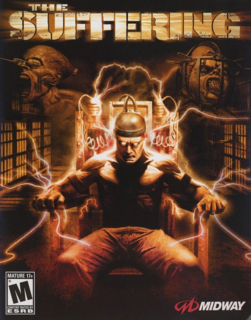The Suffering is a dark, gloomy, gory mind-freak. These are a few of my favorite things.
Although each of The Suffering’s human character models share that “we were designed for less-powerful consoles, but spruced up for a visit to your PC” blandness that I associate with many ported games, they are still expressive enough to add the right amount of drama to the proceedings. The real treat, however, is in Winston Studios’ treatment of the tortured souls that chase our hero from one end of Carnate island to the other. Each critter is a manifestation of some awful event related to capital punishment or mob justice – hanging, lethal injection, decapitation, live burial, execution by firing squad, immolation, and even the eternal taint that trading in human slaves leaves on one’s soul – and many are genuinely formidable in their own way. Like Torque, the game’s protagonist, Carnate’s supernatural inhabitants are monsters with strong human traits (or vice-versa, depending on how well Torque plays with others), twisted by the nature of their own demise and their time spent trapped, awaiting resurrection, in their own terrible version of a Micmac burial ground. I really enjoyed squaring off against such inventive and genuinely difficult foes. The character of Dr. Killjoy was ingenious -- existing only as he does through the wan flicker of strategically-positioned projectors – and I was always interested in the perpetually electrified presence of Horace and the breathy, tranquil menace of Hermes as the rest of Torque’s Greek chorus.
The game’s layout was also very well done, with the right amount of time spent creeping through incredibly dark prison and cave corridors balanced against an occasional furlough to the surrounding shoreline. Corpses abound, and how: wards and warders alike lay or hang wherever they were taken by surprise, many in pieces. Those who remain are nearly as helpless as babies – with the exception of Torque’s erstwhile detractor Officer Alvarez, whose skill with a Tommy gun is irreplaceable against those doggone Inferna witches later in the game – which is where the player’s Light Side/Dark Side tendencies will trigger some posthumous praise or scolding from Torque’s murdered wife: help a brother out, and Torque will receive the happiest ending that a guy like him might expect; murder anyone who asks for a leg up, and Torque’s inner monster comes out to play; save some and leave others, and I don’t know what happens because I wasn’t particularly interested in the “neutral” ending. Still, I can appreciate any game that tries to tailor its contents, however slightly, to my actions and accomplishments.
If I have any complaints about the The Suffering, they are a few minor quibbles related to the game’s voice acting. Grown-ups don’t often provide a convincing portrayal of a child’s voice. Although the voiceover work of E.G. Daily, Yeardley Smith, and Nancy Cartwright springs immediately to mind as a marvelous exception to that statement, The Suffering is not a cartoon – far from it; the game presents its subject matter without a smidgen of levity (although the odd but effective “chicken gun” that I found while rummaging around the prison’s solitary confinement block might count as such) – so the squeaky baby babble ascribed to Torque’s younger son was severely misplaced. Every time the little drowned rugrat opened his mouth, I couldn’t stop thinking about how much more creepy and heartbreaking his part of the story might be if it was presented by a talented kid instead of an adult using a Betty Boop affectation.
Honestly, that’s all the grousing I could muster for The Suffering. I was never bored, only occasionally frustrated (I love a good challenge, but the game’s Hard setting was downright ridiculous in spots), and found myself flinching as the overlaid glimpses into Torque’s insanity flashed across the screen. The morosely utilitarian atmosphere of the old prison – decorated as it was with fresh streaks of gore across every surface – provided an ideal setting for a haunted house tour that never once promises to end well, at least for the protagonist. Although I don’t recommend The Suffering for anyone prone to depression – this really is a very somber trek through a thoroughly dark place – any explorers with a bent for boogers and haints should enjoy a few late evenings with Torque and his demonic alter-ego.

